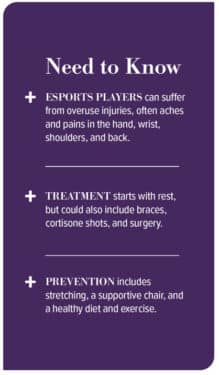The medical consequences of gaming and esports
The call of Call of Duty — a top-selling (400 million copies worldwide), first-person shooter video game — has kept Gabriel Dimperio seated for eight to 10 hours at a time, waging battle in virtual worlds. And he’s felt it in his back. “It’s something you power through,” says Dimperio, a Roosevelt University senior and member of the school’s esports program.
But Dimperio also takes the kind of preventive steps that doctors say gamers need to avoid life-long injuries. The 21-year-old works out, focusing on strengthening his core with planks, leg lifts, and lunges. “One of the top reasons why I [work out] is to keep my body to be able to sit in that chair,” Dimperio says.

With a current global market value of more than $1 billion, according to research firm SkyQuest Technology, competitive gaming is expected to reach $2.8 billion by 2028. Behind that growth is an army of esports athletes who can spend hours a day at their game consoles. And just like classical violinists or professional baseball players who move in the same ways repeatedly, they too experience the aches and pains of playing for hours on end.
“Esports are here to stay,” says Anthony Romeo, MD, an orthopedic surgeon and executive vice president of Duly Health and Care’s Musculoskeletal Institute. “And the principles that we use in high-level human performance are the same no matter what you do, including esports.”
Pain in the back, hand, wrist
Romeo’s typical patient with gaming-related injuries doesn’t always connect their pain or weakness with gaming. “It seems like there’s a lack of awareness and a lack of understanding, that if you do anything on a repetitive basis for a long period of time and don’t allow the muscles and tendons to recover. Then, injury can set in and it can worsen over time,” he says.
Back, neck, and shoulder issues can cause problems for gamers who sit hunched over for hours on end. So can overuse injuries to the hand and wrist as they constantly punch buttons, click keys, and maneuver a mouse.
Common diagnoses, Romeo says, include tendinitis, or the inflammation of a tendon, in the thumb and shoulder. Carpal tunnel syndrome, which results from pressure on the median nerve in the wrist, creates another source of numbness and pain. Gamers can even experience “tennis elbow,” with pain on the outside of the elbow joint.
Rest and recovery
At home, when dealing with achy wrists or stiff thumbs, an ice pack may reduce inflammation, and an anti-inflammatory, such as acetaminophen or ibuprofen, may help with pain, says Xavier Simcock, MD, an assistant professor of orthopedics at Rush University Medical Center.
Rest is another first step toward recovery. “No gamer wants to be told to take a little time away, but activity modification is usually first,” Simcock says.

In the most extreme cases, surgery may be required. However, Romeo, who also treats professional baseball and football players, cautioned that people may not be able to return to their top level of play after surgery. “With any surgery, you’re in a career-threatening and potentially career-ending situation,” he says. Surgery should be a final option after non-surgical options have failed.
Your body, your machine
Of course, the best way to avoid surgery is to fend off gaming injuries from the start. Stretching your hands, wrists, arms, and shoulders before play is important, Romeo says. Simcock suggests investing in an ergonomic chair that encourages proper posture, and gel pads to support your hands and wrists while you play.
And, just like any athlete, staying fit, eating healthy foods, and getting enough sleep are key too, Romeo says. “Your body is your machine, and you need to treat it like it’s the device that brings you your success.”
Adam Abbas, 30, owner of Midlane Esports, a gaming lounge and bar in Logan Square, took these steps when his back and knee pain worsened from play. He started to exercise, stretched, improved his diet, and found the regimen worked. Now, he’s thinking about planning exercise classes for gamers at Midlane. Abbas says, “A well-balanced diet and exercise directly translate to better performance in gaming.”
Originally published in the Fall 2022/Winter 2023 print issue.

Sarah Lindenfeld Hall is a longtime journalist, specializing in aging, parenting, caregiving, health, and business management topics.












